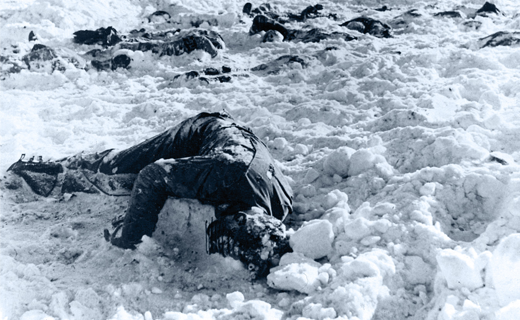Fatal Crossroads

Figure 3b. Bodies of American soldiers slain by the Nazis after capture near Malmedy, Belgium. (Public domain. Photo in National Archives and Records Administration holdings)
At about noon Dec. 17, a powerful German column was moving westward, led by 29-year-old SS LTC Jochen Pieper. Piper had been given the mission to break through American lines with a kampfgruppe (task force) of 1st SS Division, partially armed with Royal Tigers. Gaining the moniker “Blowtorch” from his brutal tactics on the Eastern Front, Piper was a cultured yet fervent Nazi who was determined to maintain the attack’s momentum.
Company B, 285th Field Artillery Observation Battalion, was a small unit attached to 7th Armored Division moving along the eastern route. The 285th made a short pause at a crossroads named Baugnez, a few miles south of Malmedy. The unit leaders got out to speak with a few local Belgians to confirm directions. Suddenly Pieper’s column appeared from an intersecting road. Tank cannon fired and machinegun bullets ripped through the icy air. The stunned Americans, outnumbered and lightly armed, immediately realized there was only one option: surrender.
Pieper himself moved in pursuit. Soon a collection of about 120 American soldiers was gathered into formation on a field adjacent to the side of the road. Individual vapor clouds of breath swirled upward in the bitterly cold air as the nervous soldiers contemplated their fate. What came next was substantiated in statements and interviews painstakingly collected after the incident. A German machinegun suddenly began firing directly into the human mass, killing and severely wounding dozens of men. Some ran and were shot. Most crumpled to the ground. Witnesses later remembered the sounds of moans and screams. German soldiers then walked among the bodies and shot those who appeared to be alive. Some feigned death and attempted to suppress evidence of breathing. At some point later, the SS men remounted their vehicles and drove off. As follow-on German columns passed by, a few took potshots into the human mass with as much regard as drunken teenagers shooting out street lamps.
Miraculously, a few Americans were alive, either wounded or unscathed. After lying for an eternity, the survivors slowly rose and ran off into the woods to tell their ghastly tale. Almost a month later, American forces would discover more than 80 bodies, still frozen in the agony of death. The incident would become known as the Malmedy Massacre.
 email
email print
print